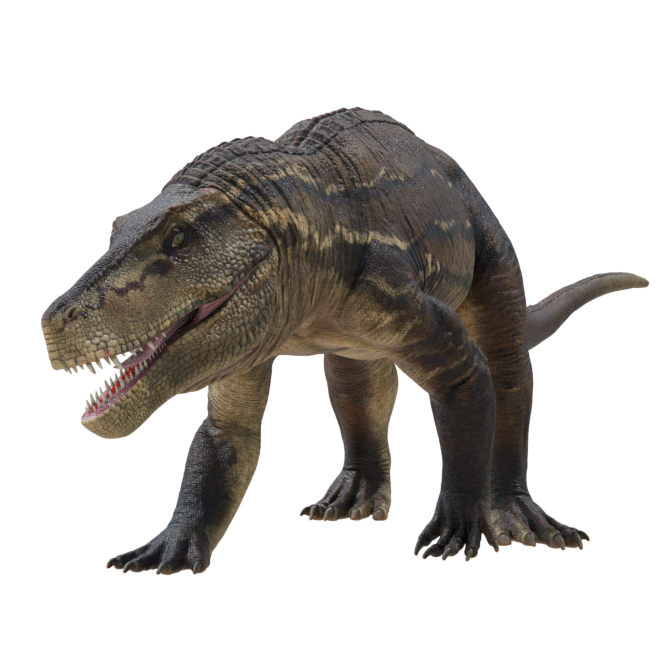Bane of the First Dinosaurs
This distant cousin of crocodilians was the top terrestrial predator in Triassic Argentina when dinosaurs were just getting started.
Overview: South America about 231 million years ago was the cradle of dinosaur evolution, but at this time, dinosaurs were not the top of the food chain. The region's top-dog, or rather top-croc, was Saurosuchus, a giant terrestrial cousin of crocodilians, discovered in the mid-20th century in the famous Ischigualasto Formation of Argentina. It was the undisputed apex predator of its ecosystem, terrorizing the dinosaurs in their early years, as well as the ancient relatives of mammals.
Discovery: The holotype (original specimen) of Saurosuchus galilei (PVL 206), which consisted of a nearly complete skull, was discovered in the Ischigualasto Formation of the Ischigualasto-Villa Unión Basin near San Juan, Argentina, by Galileo J. Scaglia and Leocadio Soria in 1957. It was described and named in 1959 by Osvaldo A. Reig. Its name is Greek, meaning “Lizard Crocodile” from “sauros”, meaning lizard, and “souchus”, meaning crocodile, fitting for a creature that was probably similar to a cross between a crocodile and a Komodo dragon. The species name honors Galileo Scaglia, who both discovered and prepared the holotype. Since then, additional specimens have been discovered from the Ischigualasto Formation, as well as some fragmentary remains that may belong to Saurosuchus from the Chinle Formation of Arizona, USA.
Evolution: Saurosuchus is a member of the clade Pseudosuchia (meaning “false crocodiles”), which includes all archosaurs closer to crocodiles than to reptiles. Within this larger group, the evolutionary relationships of Saurosuchus and its relatives becomes harder to pin down. It was once thought that Saurosuchus and similar animals such as Prestosuchus, Postosuchus, and Rauisuchus formed a group called Rauisuchia, though Prestosuchus and Saurosuchus fell outside of the family Rauisuchidae proper, However the clade Rauisuchia has been found to be paraphyletic, meaning it doesn’t include all descendants of its members, namely, it doesn’t include the Crocodylomorpha. So “rauisuchian” is more of an evolutionary grade, than a true phylogenetic clade in the strict sense. Sometimes Saurosuchus is placed in the family Prestosuchidae, but this may be invalid as well. More simply, Saurosuchus was a member of the clade Loricata, which includes the “rauisuchians” (which in turn includes the rauisuchids) as well as the crocodylomorphs. So it was a rauisuchian-grade non-rauisuchid loricate. Pretty simple right? Don’t worry if you’re confused. The world of phylogenetics can get rather confusing at times, especially when it comes to these beasts of the Triassic. For our purposes here, it will be referred to as a “rauisuchian”, meaning a non-crocodylomorph loricate.
Physical Description: Saurosuchus, like many other “rauisuchians” looked vaguely like a crocodile, but it was terrestrial. It differed from crocodiles in lacking a sprawling stance, instead holding its legs directly underneath its body, which allowed it to run faster over land. Its eyes were also not on top of its head, unlike crocodiles, and it also had a deeper skull and large blade-like serrated teeth instead of conical teeth, all typical of a terrestrial, rather than an aquatic predator. Saurosuchus was quadrupedal and heavily built and had rows of osteoderms (the boney armored plates on the backs of crocodiles) running down its back in two rows. It was very large, easily the largest predator in its environment, and one of the largest of the “rauisuchians”. Early estimates put it around 5.5 m (18 ft) long with a weight of over 250 kg (550 lbs). Newer estimates put it at 7 m (23 ft). At that length its weight may have been comparable to the extant Saltwater Crocodile, which attains a similar length, and which can weigh 1,000–1,500 kg (2,200–3,300 lbs).
Ecology: Saurosuchus was the top predator in the Ischigualasto Formation which represents a rich floodplain environment with abundant plants, including ferns, horsetails, and cycads, and towering above them, relatives of ginkgoes, monkey puzzles, and redwoods. The climate was lush enough to support these plants, but rain was highly seasonal, and there was probably a distinct wet and dry season. Large herbivores included the dicynodonts Ischigualastia and Jachaleria, the herbivorous cyndont Exaeretodon, and the aetosaur (an armored herbivorous relative of crocodiles) Aetosauroides. Small herbivores would have included rhynchosaurs like Hyperodapedon, enigmatic dinosaur-like silesaurids like Pisanosaurus, and the omnivorous sauropodomorph Panphagia. Small predators included cynodonts, the early crocodylomorph, Trialestes, and the early dinosaurs Eodromeus and Eoraptor. Larger predators included herrerasaurids, like the 6 m (20 ft) long Herrerasaurus. Saurosuchus likely competed with Herrerasaurus for some of the same food sources, though only Saurosuchus would have been large enough to take on large adult herbivores like Ichigualastia. Studies on the brain cast of Saurosuchus indicate that it probably relied more on smell and low frequency sounds to track its prey, rather than eyesight. Studies on the skull of Saurosuchus show that it had a relatively weak bite force, and therefore probably only ate the softer parts of a carcass and avoided eating bone. This wastefulness would have proved a great benefit to other carnivores in the environment, which probably regularly scavenged Saurosuchus kills. Near waterways, juvenile Saurosuchus probably would have had to be wary of semiaquatic predators like the large temnospondyl amphibians Promastodonsaurus and Pelorocephalus and the crocodile-like proterochampsid reptile Proterochampsa. However, an adult Saurosuchus likely had nothing to fear from these other predators. Saurosuchus may have even occasionally preyed on the giant amphibians, potentially reenacting a predator-prey relationship thought to have existed between the European Mastodonsaurus and Batrachotomus, close relatives of Promastodonsaurus and Saurosuchus respectively. It is safe to say that the only creature an adult Saurosuchus would have feared was another Saurosuchus.
Extinction: Saurosuchus ruled Argentina from about 231 to 227 million years ago. While it went extinct sometime after this, its kind continued on throughout the Triassic. By 220 million years ago, Saurosuchus had been replaced by an even larger “rausuchian”, Fasolasuchus, which could achieve lengths of up to 10 m (33 ft). Rausuchians continued to be the world’s top terrestrial predators until they were replaced by theropod dinosaurs at the end of the Triassic and in the Early Jurassic. Saurosuchus skeletal displays can be seen in museums such as the museum in Ischigualasto Provincial Park in San Juan, Argentina, and the Mori Arts Center Gallery in Tokyo, Japan. A relative of Saurosuchus, Postosuchus, appeared in the first episode of the 1999 BBC documentary Walking with Dinosaurs. While it is debated if Postosuchus was bipedal or quadrupedal, in the documentary it is reconstructed as a quadruped with a build similar to Saurosuchus.
Saurosuchus FAQ
Saurosuchus size / How big was Saurosuchus?
See height, weight and length.
Saurosuchus height / How tall was Saurosuchus?
Saurosuchus would have stood somewhere around 1.7 meters (5.58 ft) tall!
Saurosuchus weight / How much did Saurosuchus weigh?
Saurosuchus probably weighed around 1,000–1,500 kg (2,200–3,300 lbs)!
How long was Saurosuchus?
Saurosuchus was about 7 meters (23 ft) long.
What did Saurosuchus eat?
Saurosuchus was an apex predator. Its prey probably included the large herbivorous Dicynodonts, like Ischigualastia, as well as early dinosaurs!
What is Saurosuchus’s closest living relative?
The closest living relatives of Saurosuchus are crocodilians like alligators and crocodiles.
Saurosuchus family members / Saurosuchus family / What kind of animal was Saurosuchus?
Saurosuchus was a “rauisuchian” in the extinct family Prestosuchidae, a family of terrestrial crocodile-relatives in the clade Loricata which includes “rauisuchian” grade croc relatives and true crocodylomorphs themselves. Loricata is part of the Pseudosuchia, which includes all archosaurs closer to crocs than to birds/dinosaurs.
Where did Saurosuchus live? / Where was Saurosuchus found?
Saurosuchus lived in what is now Argentina.
When did Saurosuchus live?
Saurosuchus lived about 231.4-227 million years ago during the Late Triassic Period.
What does Saurosuchus mean? / Saurosuchus name meaning
Saurosuchus means “lizard crocodile”.

